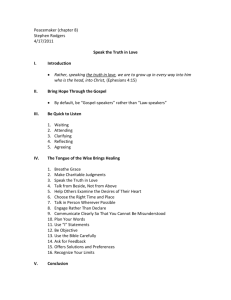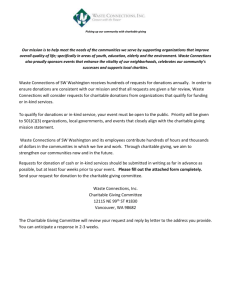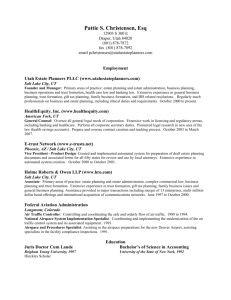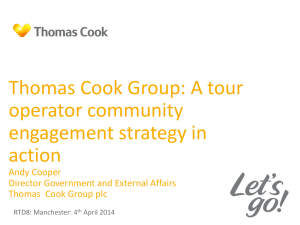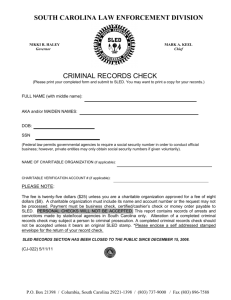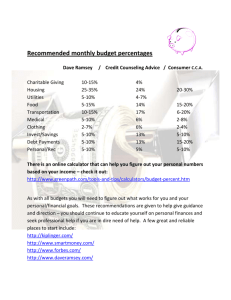Dr. R ussell James Texas Tech University
advertisement
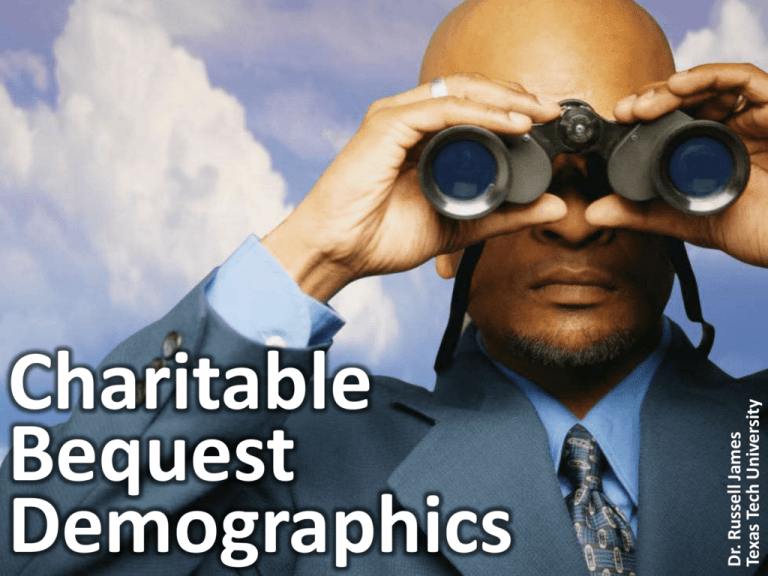
Dr. Russell James Texas Tech University Charitable Bequest Demographics What do we know about who makes charitable plans and charitable bequests? Dr. Russell James Texas Tech University Previous studies One time survey • Non-response bias if the whole survey was about charitable giving After death distributions • Only for taxable estates • Rare single county probate studies Current study Longitudinal Same people asked every two years Distributions After death nearest relatives are asked about final distributions New Questions Changes Not just who has charitable plans but when do they add and drop them Intentions v. Outcomes Did during life plans result in after death distributions Details • Nationally representative of over 50 population since 1998. • Over 20,000 people per survey. • In person interviews, some follow up by phone. • Started in 1992 • Questions within larger Health & Retirement Study • Respondents paid What share of people over 50 in the U.S. have “made provisions for any charities in [their] will or trust?” U.S. Over 50 Population No Charitable Plans, 94.3% Charitable Plans, 5.7% * Weighted nationally representative 2006 sample U.S. Over 50 Population Charitable Plans, 5.7% No Planning Documents, 56.10% Plans Without Charity, 38.2% * Weighted nationally representative 2006 sample What share of over-50 charitable donors giving over $500 per year indicate that they have a charitable estate plan? Over-50 Donors with Charitable Plans, 9.4% Over-50 Donors With No Charitable Plans, 90.6% * Donors giving $500+ per year, weighted nationally representative 2006 sample Can that be right? • Maybe a lot of donors will eventually get around to making a charitable plan? Will donors ever get around to making a charitable plan? Projecting based on age, gender and mortality or tracking actual post-death distributions 88%-90% of donors ($500+/year) over age 50 will die with no charitable estate plan. You mean 90% of our donors will die without leaving a gift? You mean we could generate 9 times more estate gifts from our current donors? Among donors ($500+) over 50 with an estate plan, what is the single most significant factor associated with having a charitable estate plan? Age? Education? Wealth? Income? Among Donors ($500+) with an Estate Plan Family Status No Offspring Children Only Grandchildren % indicating a charitable estate plan 50.0% 17.1% 9.8% Regression: Compare only otherwise identical people Example: The effect of differences in education among those making the same income, with the same wealth, same family structure, etc. Likelihood of having a charitable plan (comparing otherwise identical individuals) • • • • • • • • • • • • • • • Graduate degree (v. high school) Gives $500+ per year to charity Volunteers regularly College degree (v. high school) Has been diagnosed with a stroke Is ten years older Has been diagnosed with cancer Is married (v. unmarried) Diagnosed with a heart condition Attends church 1+ times per month Has $1,000,000 more in assets Has $100,000 per year more income Is male (v. female) Has only children (v. no offspring) Has grandchildren (v. no offspring) +4.2 % points +3.1 % points +2.0 % points +1.7 % points +1.7 % points +1.2 % points +0.8 % points +0.7 % points +0.4 % points +0.2 % points +0.1 % points not significant not significant -2.8 % points -10.5 % points Find your estate donor… A makes substantial charitable gifts, volunteers regularly, and has B doesn’t give to charity, doesn’t volunteer, and has no children From an Australian study by Christopher Baker including 1729 wills: “Australian will-makers without surviving children are ten times more likely to make a charitable gift from their estate” How did giving during life compare with post death transfers? $ $ $ $ Estate giving and annual giving for 6,342 deceased panel members Last Annual Volunteer Hours 32.6 (6.6) Average Annual Giving $3,576 Children Only 25.4 (7.1) $1,316 $6,147 Grandchildren 23.2 (2.1) $1,497 $4,320 Total 24.3 (1.8) $1,691 $8,582 Offspring No Children Average Estate Gift Estate Giving Multiple $44,849 12.6 4.7 2.9 5.1 When did people drop charitable plans? Yes! Yes! No. What happened here? Factors that triggered dropping the charitable plan 1. Becoming a grandparent 2. Becoming a parent 3. Stopping current charitable giving 4. A drop in self-rated health 0.7226* (0.2997) 0.6111† (0.3200) 0.1198* (0.0934) 0.0768† (0.0461) Some factors that didn’t seem to matter: Change in income Change in assets Change in marital status *Fixed effects analysis including 1,306 people who reported a charitable plan and later reported When did people add charitable plans? Factors that triggered adding a new charitable plan • Starting to make charitable gifts .1531† (.0882) • An improvement in self-reported health .0927* (0.0446) • A $100k increase in assets .0061** (.0023) One factor dramatically reduced the likelihood that a new charitable plan would be added: • The addition of the first grandchild -.4641† (.2732) How often did planned bequests produce a post-death gift? Yes! Yes! Yes! No. How often did planned bequests produce a post-death gift? Yes! 40.9% Yes! 59.1% No. How often did planned bequests produce a post-death gift? 71.5% surviving spouse Yes! No. No surviving spouse 49.4% Yes! No. What’s the problem? Are mischievous heirs stealing the documents? No estate documents found 16% 14% 12% 10% 8% 6% 4% 2% 0% Reported trust with Reported trust with Reported will with Reported will with no charitable plan charitable plan no charitable plan charitable plan Does choice of planning document matter? Estates generating a charitable gift 60% 50% 40% 56% 30% 35% 20% 10% 0% Reported trust with charitable plan Reported only will with charitable plan Does document choice really matter or is it just the people who are different? Variable Charitable estate distribution Household assets prior to death Household income prior to death Married Had child(ren) and grandchild(ren) Had child(ren) only Age Male No estate documents found n Decedent had reported a funded inter vivos trust 56% $1,120,591 $78,496 47.5% 58.8% 7.5% 83.2 37.5% 3.7% 80 Decedent had reported only a will 35%** $378,361** $51,326 46.3%* 55.5% 9.6% 80.6 * 40.6% 9.2%† 218 Regression: Compare only otherwise identical people Example: The effect of differences in trusts among those with same education, income, wealth, family structure, etc. Trust increases likelihood of charitable transfer by 14-15 % points Independent Variables Intercept Linear Probability Model 0.3532 (0.0328)** Linear Probability Model -0.1882 (0.2913) I.V. Trust (Funded) 0.2093 (0.0633)** 0.1461 (0.0629)* Wealth (100k) Self-reported Health Income (100k) Married Children and Grandchildren Children Only White Black Age Male 0.0037 (0.0022) † -0.0174 (0.0241) 0.0435 (0.0198)* -0.1632 (0.0644)* -0.1172 (0.0600) † -0.2012 (0.1027) † 0.0429 (0.168) -0.1111 (0.2113) 0.0084 (0.0029)** -0.0405 (0.0599) Why are trusts more effective? Will probated 60% Charitable plan and only will 40% Will not probated Consider using a phrase such as “a dollar amount equal to 10% of my gross estate for federal estate tax purposes” Do the estates of people who make charitable estate plans grow differently than the general population? After making their plan, charitable estate donors grew their estates 50%-100% faster than did others with same initial wealth Dr. Russell James Texas Tech University Using Demographics to Make Future Projections The Fall and Rise in Live Births - US 4,500 Live Births 4,000 3,500 3,000 2,500 2,000 12,000,000 Persons Alive in America 10,000,000 8,000,000 Dramatic increases on the horizon Temporary drop in key demographic population Y2000 Y2001 Y2002 6,000,000 Y2003 Y2004 4,000,000 Y2005 Y2006 Y2007 2,000,000 0 Age Age Age Age Age Age Age Age Age Age Age 50 to 55 to 60 to 65 to 70 to 75 to 80 to 85 to 90 to 95 to 100+ 54 59 64 69 74 79 84 89 94 99 The fall and rise in live births - UK Persons alive in the UK, 2008-2030 5000 4500 4000 3500 3000 2500 2000 1500 1000 500 0 Age 50- Age 55- Age 60- Age 65- Age 70- Age 75- Age 80- Age 85- Age 90- Age 95- Age 54 59 64 69 74 79 84 89 94 99 100+ Ireland population pyramid, 2001 • Without the large post-war baby boom, expect less rapid growth in older ages • Growth will come primarily due to improved longevity Projecting future bequest giving Frequency of future bequest gifts • Change in population • Change in tendency to make bequest gifts Do the boomers give differently? • After controlling for wealth and income, the baby boom cohort gave at a significantly lower rate during middle age than the pre-war cohort did (Wilhelm, Rooney, and Tempel, 2008). • Will boomers also be less charitable in estate giving? Data • 1996-2006 Health and Retirement Study (HRS), a nationally representative, biennial, longitudinal study. • Analysis weighted to project to national means and adjusted for complex sample selection process Charitable Estate Planning among US Adults Aged 55-65 6.0% 5.5% 5.0% 4.5% 4.0% 3.5% 3.0% 1996 1998 2000 2002 2004 2006 What is driving this trend? Weighted descriptive statistics of adults aged 55-65 (‘96 & ‘06 HRS) Variable Charitable estate plan Will or trust executed Funded trust <High School High school graduate Some college College graduate Graduate education Household assets (2006$) 1996 3.81% 51.72% 4.53% 24.57% 36.22% 19.37% 8.82% 10.82% $384,419 (771,398) [$15,092] 2006 5.43%* 43.63%* 6.60%* 14.76%* 30.73%* 24.77%* 13.53%* 15.55%* 686,258 (3,421,725) Δ% 42.5% -15.6% 45.7% -39.9% -15.2% 27.9% 53.4% 43.7% 78.5% [$69,935]* Household income (2006$) $76,372 (99,274) [$2,287] 100,865 (530,858) 32.1% [$12,037]* Charitable giving >$650 Number of children Number of grandchildren No children No grandchildren 33.85% 3.30 (2.17) [0.03] 4.48 (5.10) [0.10] 6.83% 21.03% 36.27%* 2.83* (2.01) [0.03] 3.79* [4.94] (0.08) 8.34%* 29.1%* 7.1% -14.2% -15.5% 22.1% 38.4% Charitable estate planning among adults aged 55-65 40% 35% 30% No Children - No College Degree 25% No Children College Degree 20% Children - No College Degree 15% Children - College Degree 10% 5% 0% 1996 1998 2000 2002 2004 2006 Increases in charitable planning are driven by increases in childlessness and education Time trend exists Variable Year Any children Years of Education Estimate (s.e.) 0.0138 (0.0032) p-value Time trend disappears when including childlessness and education Estimate (s.e.) <.0001 0.0033 (0.0034) -0.6251 (0.0345) 0.1412 (0.0048) p-value Estimate (s.e.) p-value 0.3298 0.0015 0.664 (0.0036) <.0001 -0.6224 <.0001 (0.0479) <.0001 …. …. full set of control variables Probit analysis of all respondents age 55-65 in 1996-2006 HRS. Outcome variable is the presence of charitable estate planning. Basic relationship • This suggests that the overall trend of increased charitable estate planning may have been driven, in large part, by changes in childlessness and education. • Such a relationship has important implications for predicting charitable estate planning levels in the future. Upcoming cohorts and childlessness • Childlessness among women who will be entering the 55-65 age group over the next decade will be substantially higher than those in the 55-65 age group during 2006 (the year of the latest HRS survey). • Women in the 56-61 age group during 2006 reported a childlessness rate of 16.0% in 1990 when they were aged 40-44 (Dye, 2005). In comparison, women in the 40-44 age range in 2004 (i.e., those who will begin entering the 5565 near retirement age group in 2015) reported a childlessness rate of 19.3% (Dye, 2005). Similar trends in U.K. Source: http://www.statistics.gov.uk/cci/nugget.asp?id=369 http://www.statistics.gov.uk/articles/population_trends/birthstats_pt94.pdf Upcoming cohorts and education • Similarly, a college education is much more common among the upcoming cohorts of individuals nearing retirement age than among the current 55-65 group (Stoops, 2004). • In 1996, less than 27% of those in the 35-54 age group had at least a bachelor’s degree. • By 2007, over 31% of those in the 35-54 age group had at least a bachelor’s degree (Current Population Survey, 2007). • Thus, one can expect the upcoming cohorts of individuals nearing retirement to be more educated than individuals currently in the 55-65 age group. Growth trends in charitable estate planning 1. Overall graying of the population 2. Increased childlessness of upcoming and future cohorts 3. Increased education of upcoming and future cohorts The financial planner without a basic understanding of planned giving options may leave greater and greater numbers of clients underserved. Photos from www.istockphoto.com Charitable Bequest Demographics Help me convince my bosses that continuing to build and post these slide sets is not a waste of time. If you work for a nonprofit or advise donors and you reviewed these slides, please let me know by clicking HERE If you clicked on the link to let me know you reviewed these slides… Thank You! For the audio lecture accompanying this slide set, go to EncourageGenerosity.com Think you understand it? Prove it! Click here to go to EncourageGenerosity.com and take the free quiz on this slide set. (Instantly graded with in depth explanations and a certificate of completion score report.) Graduate Studies in Charitable Financial Planning at Texas Tech University This slide set is from the introductory curriculum for the Graduate Certificate in Charitable Financial Planning at Texas Tech University, home to the nation’s largest graduate program in personal financial planning. To find out more about the online Graduate Certificate in Charitable Financial Planning go to www.EncourageGenerosity.com To find out more about the M.S. or Ph.D. in personal financial planning at Texas Tech University, go to www.depts.ttu.edu/pfp/ About the Author Me (about 5 years ago) ® Russell James, J.D., Ph.D., CFP is an Associate Professor and the Director of Graduate Studies in Charitable Planning in the Division of Personal Financial Planning at Texas Tech University. He graduated, cum laude, from the University of Missouri School of Law where he was a member of the Missouri Law Review. While in law school he received the Lecturing in Germany. 75 extra students United Missouri Bank Award for Most Outstanding Work in Gift and Estate Taxation showed up. I thought it was for me until I and Planning and the American Jurisprudence found out there was free beer afterwards. Award for Most Outstanding Work in Federal Income Taxation. After graduation, he worked At Giving Korea 2010. I as the Director of Planned Giving for Central didn’t notice until later Christian College, Moberly, Missouri for six the projector was years and also built a successful law practice shining on my head (inter-cultural height limited to estate and gift planning. He later problems). served as president of the college for more than five years, where he had direct and supervisory responsibility for all fundraising. Dr. James received his Ph.D. in Consumer & Family Economics from the University of Missouri where his dissertation was on the topic of charitable giving. Dr. James has over 100 publications in print or in press in academic journals, conference proceedings, professional periodicals, and books. He writes regularly for Advancing Philanthropy, the magazine of the Association of Fundraising Professionals. He has presented his research in the U.S. and across the world including as an invited speaker in Ireland, Scotland, England, The Netherlands, Spain, Germany, and South Korea. (click here for complete CV)


